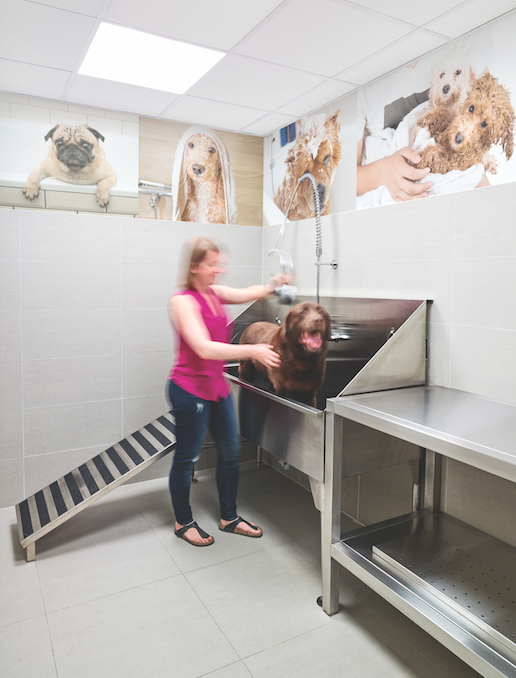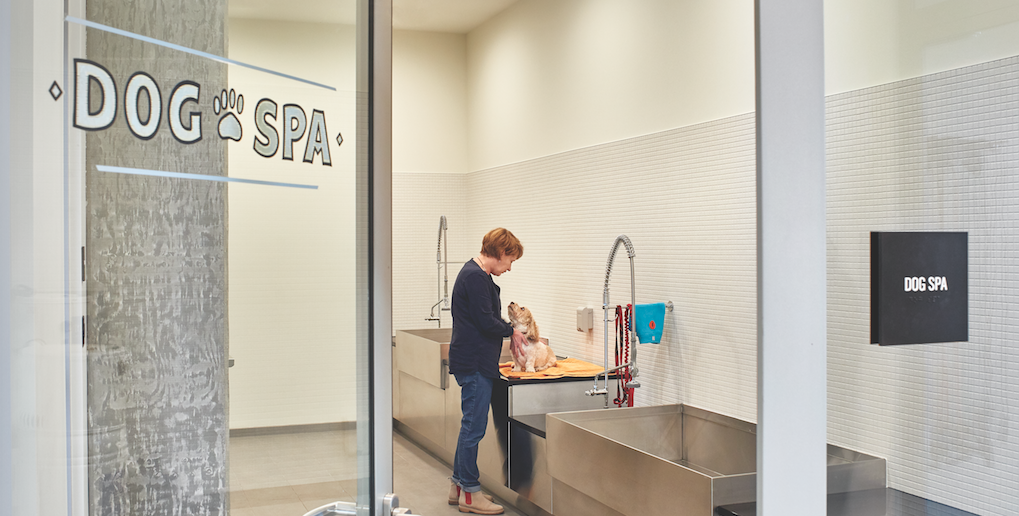There’s a construction boomlet under way in dog-washing facilities at U.S. and Canadian apartment and condominium communities.
Half of U.S. dog owners live in the 25 largest U.S. metro areas, where dog-focused amenities are common at apartment and condominium properties. More than half (55.2%) of respondents to this publication’s 2017 “Amenities Survey” said they had installed a dog-wash spa in a multifamily project.
Dog ownership has risen 29% in the past decade, claims pet-food market researcher Packaged Facts. According to the American Veterinary Medical Association, singles and renters make up the fastest-growing group of new dog owners.
Dog-washing stations provide renters and condo owners with an on-site amenity that’s a lot more practical than bathing a pup in a ceramic or fiberglass tub intended for humans. “Most tubs in multifamily building units have a conventional kitchen sink drain that can easily clog with dog fur, leading to maintenance and hygiene issues,” said Gary Sherman, Founder/CEO, Evolution Dog Wash Company, Los Angeles, who has installed about 50 such systems in residential buildings in North America.
The cost of installing a dog wash station can run from $3,500 to $8,000 per tub with all equipment, said Dan Hembree, President, Hemcor Construction, Cary, N.C. Some multifamily communities offer it as a free amenity; others charge a one-time fee or a per-use or monthly fee.
We asked four experienced professionals about installing these amenities. Here’s what they recommended.
Select a convenient location. Our experts recommend locating the dog-wash stations close to elevators, with easy access to the exterior, if possible.
The dog spa at the 41-story Quartz at City Place condominium tower in downtown Toronto is adjacent to a small outside dog park, which is accessible through a side entrance. “Residents can whisk their muddy dogs inside quickly and without tracking them through the main lobby area,” said Dominic De Freitas, ARIDO, IDC, NCIDQ, Vice President of Residential Development at interior design firm figure3, Toronto.
Size it right. Dog-washing spaces range in size from 100 sf to more than 1,000. The most basic house a utility sink and a few prefabricated stainless-steel tubs, said architect Brian Romanelli, Associate, Solomon Cordwell Buenz, Chicago. Larger, more sophisticated dog spas feature custom-designed systems with wall-mounted blow dryers and grooming tables. Rooms should be adequately sized to give dog owners easy access to all equipment, he said.
Connect the space to other pet amenities. At AMLI Residential’s new AMLI Arc luxury apartment tower in downtown Seattle—a city where pets far outnumber children—the “Canine Social Club” in the 12th-floor amenities space has a dog spa with two self-serve washing areas and a grooming station with a hydraulic lift. The space is adjacent to an indoor-outdoor pet lounge that’s connected to a semi-outdoor dog run with artificial turf.

The dog-washing station at the Quartz Condos at Concord CityPlace in Toronto. Photo: Steve Tsai
“We were able to create a large, playful space that benefits both the residents and their pet family members,” said Camilla Watson, Interior Designer, ZGF Architects, Seattle.
Where there are multiple tubs, position the water valves on opposite sides of the tubs, so that two dogs aren’t facing each other while bathing. “Helps avoid conflict,” said Hembree.
Provide a ramp for the dogs, especially larger species, to get into the tub. “It can be a strain to hoist and control a rambunctious pup who isn’t crazy about getting wet and soapy,” said Sherman.
Never ignore aesthetics. Developers want to avoid making dog-grooming spaces feel like utilitarian, back-of-house facilities, said De Freitas. “There’s more of a focus to create a spa-like environment, especially in purpose-built rental projects,” he said.
At the Sinclair, a 35-story, 390-unit luxury apartment tower in Chicago’s Gold Coast neighborhood, the finishes in the dog spa are consistent with the project’s other amenity spaces. “Tile floors, wainscoted walls, custom decorative lighting, and natural-toned finishes were incorporated throughout the space” as requested by the developer (Fifield Companies), said Romanelli.
Pay close attention to maintenance, air quality, and noise. Select wall and floor finishes that are easy to clean and resistant to moisture, including slip-resistant floors with a dog-friendly coating, said Romanelli. “It’s also important to provide adequate ventilation to ensure that no strong odors leave the room.” Sound-absorbing ceiling tiles and other acoustical treatments can prevent boisterous barks from penetrating into adjacent spaces.
Make sure electrical outlets are designed to accommodate hair dryers—in some cases, a 220-volt receptacle may be needed. Install wall-mounted hair dryers within easy reach of human users. If necessary to avoid accessibility problems, have the manufacturer weld custom brackets underneath the grooming table, said Hembree.
Specify non-slip grooming mats on drying tables. “A good rubber mat allows the wet animal to stand comfortably without fear of slipping,” said Hembree.
Look into built-in storage. The dog spa at AMLI Arc has open bins for residents to store their supplies short-term and lockers for long-term storage, said Watson.
Build community. Pet owners gravitate toward other pet owners, and dog-washing stations can serve as social connectors in multifamily communities. “We’re seeing a big push to create a community-like environment within a building,” said De Freitas. “As these spaces continue to get larger, they’re inevitably going to become more social as well.”
At a new apartment building De Freitas is designing in downtown Toronto, the glass-fronted dog-wash room will be clearly visible from the main lobby. “We want the lobby to feel active and conducive to community,” he said. “So many people in these buildings have dogs. We’re trying to celebrate that, instead of hiding it.”
Prepare for future enhancements. De Freitas predicts that professional dog-grooming services, such as nail trimming and shearing, will become more common as developers and property managers test new and more elaborate pooch-friendly services.
Related Stories
| Aug 11, 2010
Housing America's Heroes 7 Trends in the Design of Homes for the Military
Take a stroll through a new residential housing development at many U.S. military posts, and you'd be hard-pressed to tell it apart from a newer middle-class neighborhood in Anywhere, USA. And that's just the way the service branches want it. The Army, Navy, Air Force, and Marines have all embarked on major housing upgrade programs in the past decade, creating a military housing construction boom.
| Aug 11, 2010
Loft Condo Conversion That's Outside the Box
Few people would have taken a look at a century-old cigar box factory with crumbling masonry and rotted wood beams and envisioned stylish loft condos, but Miles Development Partners did just that. And they made that vision a reality at Box Factory Lofts in historic Ybor City, Fla. Once the largest cigar box plant in the world, the Tampa Box Company produced boxes of many shapes and sizes, spec...
| Aug 11, 2010
World's tallest all-wood residential structure opens in London
At nine stories, the Stadthaus apartment complex in East London is the world’s tallest residential structure constructed entirely in timber and one of the tallest all-wood buildings on the planet. The tower’s structural system consists of cross-laminated timber (CLT) panels pieced together to form load-bearing walls and floors. Even the elevator and stair shafts are constructed of prefabricated CLT.
| Aug 11, 2010
CityCenter Takes Experience Design To New Heights
It's early June, in Las Vegas, which means it's very hot, and I am coming to the end of a hardhat tour of the $9.2 billion CityCenter development, a tour that began in the air-conditioned comfort of the project's immense sales center just off the famed Las Vegas Strip and ended on a rooftop overlooking the largest privately funded development in the U.
| Aug 11, 2010
Giants 300 Multifamily Report
Multifamily housing starts dropped to 100,000 in April—the lowest level in several decades—due to still-worsening conditions in the apartment market. Nonetheless, the April total is below trend, so starts will move progressively back to a still-depressed 150,000-unit pace by late next year.
| Aug 11, 2010
The softer side of Sears
Built in 1928 as a shining Art Deco beacon for the upper Midwest, the Sears building in Minneapolis—with its 16-story central tower, department store, catalog center, and warehouse—served customers throughout the Twin Cities area for more than 65 years. But as nearby neighborhoods deteriorated and the catalog operation was shut down, by 1994 the once-grand structure was reduced to ...
| Aug 11, 2010
Gold Award: Westin Book Cadillac Hotel & Condominiums Detroit, Mich.
“From eyesore to icon.” That's how Reconstruction Awards judge K. Nam Shiu so concisely described the restoration effort that turned the decimated Book Cadillac Hotel into a modern hotel and condo development. The tallest hotel in the world when it opened in 1924, the 32-story Renaissance Revival structure was revered as a jewel in the then-bustling Motor City.







